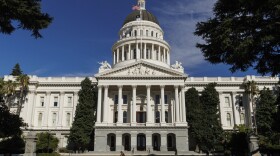
Union membership is at its lowest point since the 1930s. New figures show a drop, and only about 11 percent of workers belong to unions today.
But these numbers don't deter the New York City Labor Chorus, which has been singing in praise of unions for more than 20 years.
Jana Ballard, the choral director of the labor chorus, is one of the youngest in the group. She's 38. The average age of the 80 members is about 65.
Ballard grew up in Kentucky and now teaches voice and chorus at La Guardia High School -- often called the Fame school -- in New York City. She was intrigued when this job opening appeared, but she wasn't very familiar with labor songs.
"Even though I didn't know this music, it really hit home with me, because I understand working hard," she says. "I understand the struggles of working people."
Still, there were difficulties coming to a group of mostly elderly people, some of whom had been together for two decades. She says she's a strict teacher and her fellow songbirds were elders.
"I had to separate myself from that aspect and say, 'These are singers,' and then as we got better, people would stop and listen and pay attention," Ballard says. "And that's what I kept telling the group, 'The better we sound, [the more] people are going to pay attention to what we are singing.' "
When you hear the words "New York City Labor Chorus," you might expect old renditions of "Solidarity Forever" and "Union Maid" -- which they do perform -- being sung by aging voices. But don't underestimate them.
Chorus President Barbara Bailey recalls the inception of the chorus, when a crew of people from different unions realized that most members didn't have any knowledge of their history.
"The art of singing was being lost," she says. "A lot of union members don't know labor songs and don't know too much about labor. And we felt this would be a way of reintroducing it to some and introducing it to others."
The chorus has traveled to Sweden, Wales and Cuba. It has played at schools and strikes.
Sun Zagaib, the chorus secretary and head of the alto section, says you don't have to belong to a union to be in the chorus. "All that we ask is that you have the values and you are union sympathizers," she says.
But now that unions are weaker and under assault, the chorus is really trying to emphasize their importance, she says.
"We are forgetful; we take for granted all the advances we have made as if they would have just been there without unions," Zagaib says. She lists the 40-hour workweek, the weekend, job security, sick days as unions' efforts.
Betty Reid, a 63-year-old postal worker, says when they sing, they educate. "People will come and they'll say, 'I never knew that; I wasn't aware of that,' because a lot of this stuff is not really taught," Reid says.
Jerry Gillia, a 75-year-old former teacher, says he's a realist. Unions have shot themselves in the foot sometimes and done some bad things, he says. Most people don't understand the good that unions have done, Gillia adds.
So the question arises: Does participating in the chorus propel the union movement?
"Honestly I don't think it makes that much difference," he says.
But he and his wife keep coming back. "It gives us a chance to kind of keep our hand in," Gillia says. "We're still part of the fight, a small part, but part of the fight for the things we believe in."
When you listen to the chorus's previous recordings, it has clearly improved a lot. Its version of "Rocking Solidarity" has a soloist who could be the star of a great gospel choir.
Despite this spirit, given the weakening of unions, can a new generation be attracted to these struggles and these songs?
Bailey notes that young people today often have two or three jobs, leaving them with no time to attend rehearsals. Yet to survive, she says, the chorus needs to attract a new generation.
"Somebody has to take over from us," she says. "I have been with the chorus some 20 years and somebody has to move into this spot."
It's not clear whether that will happen, regardless of the beauty of the music.
Copyright 2013 NPR. To see more, visit www.npr.org.






